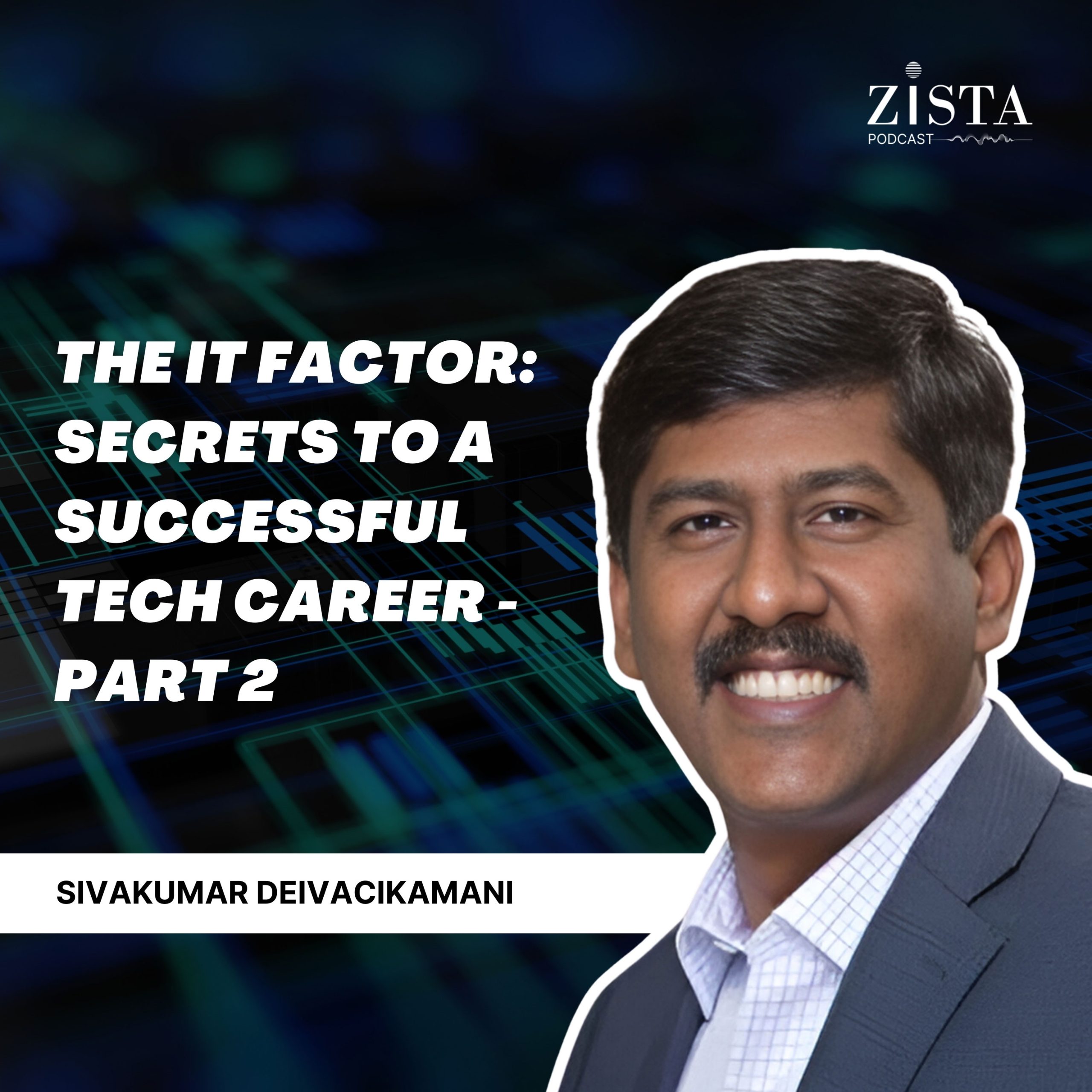A day in the life of a Telecom Business Head
Making a much-anticipated return to The Zista Podcast, a place where thought-provoking conversations come alive, we are overjoyed to welcome back Prateek Pashine. A towering figure in the telecom industry, Prateek continues to influence with his innovative mindset at Jio, India’s premier telecom company.
In this episode, we journey through Prateek’s impressive telecom career, learning about his risk management techniques, overcoming challenges, and fostering a growth mindset within his teams. Particularly beneficial for students and up-and-coming professionals, this discussion is rich with lessons on resilience, adaptability, and forward-thinking strategies.
Join us for an enlightening conversation filled with industry wisdom and captivating narratives from a telecom industry expert. Don’t miss this unique opportunity to learn from one of the industry’s most insightful leaders. Tune in now!
Greetings, listeners! It’s time for another compelling episode of The Zista Podcast, your dependable source for diverse and enlightening discussions on an array of topics. Our guest on this episode is none other than Prateek Pashine, an exceptional leader who’s been making waves in the telecom sector with his strategic acumen and innovative leadership.
Currently at the helm of the Enterprise Business at Jio, India’s foremost telecom giant, Prateek’s illustrious career spans both B2C and B2B markets, making him a versatile strategist and innovator in the field.
In today’s episode, we journey through Prateek’s career in the Telecom industry, understanding how he has navigated complex challenges and risks, and balanced significant trade-offs. Moreover, we will gain insights into his approach to nurturing innovation and fostering a ‘growth culture mindset’ in organizations, two elements that are indispensable in today’s ever-evolving digital landscape.
This episode is particularly beneficial for students and emerging professionals, providing a unique learning opportunity through Prateek’s extensive industry knowledge and practical wisdom. His experiences offer valuable lessons on resilience, agility, and forward-thinking strategies required to thrive in a competitive industry.
So prepare yourselves for a conversation replete with fascinating ideas, entrepreneurial strategies, and industry-shaping narratives.
KEY TAKEAWAYS
- Learning from Prateek’s experience, students can acquire valuable transferable skills such as project financing, sales, problem-solving, and strategic decision-making. These skills can be applied across various roles and industries within the telecom sector.
- Effective use of tools like calendars for organizing tasks and color-coding them based on priority and type of activity / discussion can help manage a dynamic work schedule and ensure focus on crucial areas.
- Recognizing whether a decision or policy impacts just one transaction (‘adder’ role) or has a larger effect on the customer’s experience or simplifies life for the sales teams (‘multiplier’ role) can help optimize the performance of an individual and a team.
- Not all innovations succeed, so it is essential to understand and accept the nature of ‘trying fast and failing fast’, underpinned by a degree of tolerance for failure.
- Similar to startups, not all innovative initiatives will yield results, but the success of a single venture could more than compensate for others. However, stability of the core business should not be compromised in the pursuit of innovation.
QUESTIONS
Q1. How did your journey begin and progress in the Telecom industry?
A: Prateek’s journey in the telecom industry began immediately after he acquired his engineering degree from RCE Nagpur, now known as VNIT. Following that, he joined IIM Bangalore and transitioned to Tata Administrative Services in 1995.
During his time with Tata, he underwent a one-year induction process that allowed him to gain exposure in auto competence, telecom services, and computing with Tata Elxsi. He was also given the opportunity to work with Tata Industries, one of the two holding companies of the group that focuses on new business.
Prateek worked on various projects during this time. For instance, he contributed to the then airport project and the first JV of Tata Singapore in the mid-1990s, which didn’t materialize. Additionally, he was involved in telecom equipment and was part of Tata Telecom, the largest PBX company in the country at the time.
Prateek was instrumental in bringing together multiple joint ventures under one fold. One of these ventures was AT&T’s equipment business, which was rebranded as Lucent Technologies. Prateek worked with Lucent for three and a half years, taking on tasks ranging from obtaining foreign investment promotion board approval to facilitating technology transfer of Lucent Technologies to India for a perpetual period.
Prateek’s diverse role at Lucent involved managing supplier agreements and project financing. As part of the MD’s office, Prateek handled unique tasks or issues that didn’t fall into any specific department.
Post his experience with Lucent, Prateek ventured into the hotel industry where he sold hotel rooms. He was also part of the team that launched the country’s first e-commerce enabled hotel website in the early 2000s, allowing individuals to book a Taj hotel room online. Prateek also contributed to several other digital initiatives at Taj.
Prateek’s journey took another turn when he joined a startup in speech recognition technology. Soon after, he moved to the Telecom services side of the business when Tata’s decided to become a national player. In this role, he worked on procurement, having had experience in project financing, selling hotel rooms and real estate, and working with Lucent Technologies.
Prateek spent about eight to nine months in data-driven telecom services during which Tata acquired VSNL, a government monopoly which had just lost its monopoly. He was given the task of handling multiple issues, a job description that was summed up as “firefighting.”
In this role, Prateek evaluated whether Tata should launch Telecom services in Kyrgyzstan, Bangladesh, and Nepal. He also contributed to establishing VSNL’s presence in the U.S.o1q and Sri Lanka. Gradually, Prateek took on the responsibility of handling one of the retail business units and product marketing for that unit.
Prateek then moved to Tata Tele services, where he managed specific business units. From there, he transitioned to Reliance Jio to set up the Enterprise business. His journey has been diverse, spanning from procurement and project financing to selling real estate, hotel rooms, technology, and now telecom services.
Q2. What is a typical day in your life?
A: Prateek’s day in the business sector is anything but typical. In fact, he cherishes the fact that each day is unique, with no Monday to Friday looking exactly alike. From dealing with customer escalations that could potentially evolve into substantial issues, to reviewing sales approaches, customer experiences, and performance, Prateek’s work is always dynamic.
A vital tool that assists Prateek in navigating his packed schedule is his calendar. He meticulously maintains it, dividing his appointments into seven to eight color codes. By merely looking at the colors on his calendar, Prateek can understand the areas that are vying for his attention, what he is focusing on and whether things are moving in the right direction. Each color represents different tasks, which could range from employee-related activities, external customer meetings, operations, to leadership meetings.
Prateek emphasizes that most people in the headquarters are often juggling two roles, which he defines as the “adder” role and the “multiplier” role. The “multiplier” role is when one’s decision or policy has a substantial impact on either the customer’s experience with your service, or simplifies life for the sales team. This multiplier effect is crucial for Prateek, and it represents an essential part of his daily or weekly schedule.
An “adder” role, on the other hand, is focused on individual transactions. For instance, if a customer wanted a specific clause in a contract, deciding whether it’s the right thing to do would be an “adder” job. It solves an issue with that one customer only and does not impact anything else.
Prateek is particularly conscientious about whether he and his team are performing “adder” jobs or “multiplier” jobs. He emphasizes the significance of the “multiplier” role at every town hall meeting, especially for his headquarters’ team, as their decisions often provide direction and establish processes, propositions, and products that the regional offices then utilize.
Q3. While running a large B2B enterprise, how do you balance the trade-offs and the risks faced in the business?
A: Prateek explains that risk is an inherent part of any business venture. Even seemingly secure activities, such as depositing money in a government bond, carry some level of risk. In running a business, especially in an enterprise context, the risks taken can vary. For instance, some might undertake market or credit risks.
Prateek provides an example from the power generation industry. Here, a business primarily takes on a credit risk, as they must rely on the electricity boards to pay after consumption. However, they don’t take a market risk, as power purchase agreements, including the price, are typically signed for durations of 10-15 years even before the actual generation. Contrastingly, in the Telecom business, both market and credit risks are present, from setting up a Telecom tower, attracting customers, and to ensuring those customers will pay.
Yet, the risks Prateek is mainly discussing here pertain to processes. Companies design processes to minimize risk, with the balance varying on a spectrum. On one end, there’s a belief that everyone is trying to take advantage, leading to tightly wound processes with multiple checks, thus creating a solid but clunky process. On the other end of the spectrum, there’s a more lenient approach with minimal checks, increasing the velocity of the process but also potentially exposing the business to risks.
Balancing these trade-offs depends on where the company wants to be on this spectrum, which in turn influences the agility of the organization. Prateek proposes a key question: do you aim to save the organization from the two bad apples at the cost of suffocating the remaining 98, or do you create a process that lets all 100 through, while simultaneously developing a post-facto method of identifying issues? The choice you make in this regard shapes not only the culture of your organization but also the experience of your customers.
Q4. How do you foster a culture of innovation and a growth mindset in an organization?
A: Prateek elaborates that innovation is fundamentally the birthplace of fresh ideas. When these ideas result in commercial success, it’s termed as commercial innovation. However, he notes that all innovations may not succeed. Some may be ahead of their time, or perhaps the market may not be ready for them. In such scenarios, Prateek advises adopting a strategy of ‘trying fast and failing fast’, underpinned by a degree of tolerance for failure. This approach involves rapid experimentation and implementation, and even if failure occurs, the lessons learned from the experience prove invaluable.
Specifically in the telecom sector, where you don’t often create entirely new network models, this approach applies to the creation of new processes, systems, and customer offerings. Prateek emphasizes on fostering a culture that encourages continuous innovation and is not afraid to try something new and untested.
Drawing a parallel with the world of startups, Prateek observes that typically, only one out of ten startups succeed. Acknowledging that not all investments will yield results, but the success of that single venture could more than compensate for the others, is vital. However, a key aspect to remember is not to compromise the stability of the core business in the pursuit of innovation.
In this process, maintaining the smooth operation of the primary business while conducting continuous experiments is crucial. If a proof of concept fails, Prateek advises the importance of understanding why it failed. Distinguishing whether the failure was due to a flawed idea or poor execution helps guide future innovative initiatives.




